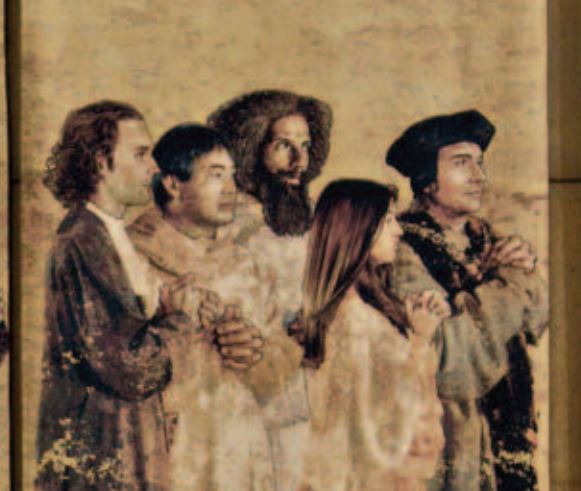 |
| Communion of Saints Tapestries by John Nava at the Cathedral of Our Lady of the Angels in Los Angeles |
It is the season of light coming into the world, yes. But it is also the season of long nights. I spent a couple of winters in Ireland, where the nights were a bit longer, and where it was damper and colder (at least indoors), and I learned what long nights are for. No, not for visiting pubs, although the purpose can be achieved there.
Long nights are for gathering together around whatever light and heat are available — a turf fire, a cup of hot tea. And they are for telling stories.
The very best stories are stories of the saints.
Before going further, I should clarify and perhaps change terminology. I know that Anabaptists and Calvinists and Pentecostals are saying, "But we don't have saints." But you do have witnesses. Examples. Folks who used their God-given gifts for the good of the church and the whole world. You have Foxe's Book of Martyrs and biographies of giants of the faith. Substitute any of these for "saints," and I'll try to do the same sometimes.
Some giants of the faith emerge from unexpected corners of history, like the virtuous woman I like to call the patron saint of development officers. Her story takes place during the early Roman persecutions of the church, when a group of young men were scheduled to be martyred together. The night before they died, a benefactress gave them a nice dinner. She may not have saved them, but she did what she could.
During those winters sitting by peat fires, I learned that the Irish have their own unique collection of larger-than-life saints, like Kevin, who threw the devil (disguised as a woman) 600 feet from his hermit's cell into a lake.
But we needn't be parochial. You've got your own cloud of witnesses.
Some stories are your very own, and like every gift, they are given to you for the good of God's people. So share them!
Some years ago, I mentioned to In Trust's then-editor that several people I loved had died within days of each other. He replied, "You know, the time comes when you know more dead people than living ones." I nodded; I'd passed that point some time before.
But the blessed dead live on in the stories we tell.
There is someone at your school with a particular gift for keeping and telling these stories. History professors sometimes fill the role, but most places have unofficial story-tellers too — perhaps former students, employees, or board members. At one school, I once spent two hours over coffee with a maintenance man who was about to retire. He knew everything about the place: a keen observer and full of insight, he could recount all the stories from all the angles.
Encouraging people who know the stories to tell them is a good way to spend a long winter's night, but it's more than that. Every school is the product of diverse gifts shared by all sorts of people. You can learn from them! Sometimes it's not the charismatic figures who make all the difference, but rather the quiet, behind-the-scenes types.
And most to the point, when you know the stories, you can thank God for the saints — the giants of the faith, or whatever you, in your own tradition, call them.
Title photo, by Richard Flynn: Communion of Saints Tapestries by John Nava at the Cathedral of Our Lady of the Angels in Los Angeles.